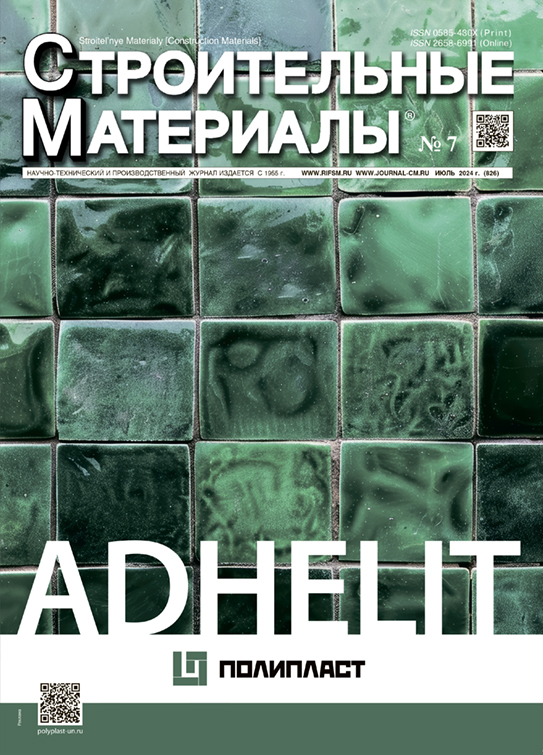Photocatalytically Active Fine-Grained Concrete Based on Titanosilicate Waste
- Authors: Tyukavkina V.V.1, Tsyryatieva A.V.1
-
Affiliations:
- Institute of Chemistry and Technology of Rare Elements and Mineral Raw Materials named after I.V. Tananaev, FRC, Kola Science Centre of the Russian Academy of Sciences
- Issue: No 7 (2024)
- Pages: 48-53
- Section: Modern concretes
- URL: https://journals.eco-vector.com/0585-430X/article/view/635045
- DOI: https://doi.org/10.31659/0585-430X-2024-826-7-48-53
- ID: 635045
Cite item
Abstract
Photocatalytically active fine-grained concrete has been developed using a titanosilicate additive, which is a waste product from the production of titanosilicate sorbent. It has been established that the introduction of a titanosilicate additive into the composition of fine-grained concrete ensures the formation of an additional amount of calcium hydrosilicates, mainly low-basic ones, increases the density of the cement stone and reduces structural defects, thereby facilitating the production of higher-strength concrete with improved technical and operational properties. For the developed concrete composition containing 2% (by weight of cement) titanosilicate powder, 1.1 wt. % Glenium 51 superplasticizer, with a W/C of 0.42, an increase in compressive strength by 52% and a decrease in water absorption by 32% were recorded, reducing the depth of wear and weight loss by 35%, increasing frost resistance by 3 grades, compared to the additive-free composition. The surface of fine-grained concrete containing waste titanosilicate sorbent, in the decomposition reaction of methylene blue, exhibits the ability to self-clean under the influence of visible light, and under ultraviolet light it exceeds samples with commercial titanium dioxide. Also, the manifestation of the self-cleaning ability of modified concrete is confirmed by a decrease in the contact angle during irradiation with ultraviolet light.
Full Text
About the authors
V. V. Tyukavkina
Institute of Chemistry and Technology of Rare Elements and Mineral Raw Materials named after I.V. Tananaev, FRC, Kola Science Centre of the Russian Academy of Sciences
Author for correspondence.
Email: v.tiukavkina@ksc.ru
Candidate of Sciences (Engineering)
Russian Federation, ApatityA. V. Tsyryatieva
Institute of Chemistry and Technology of Rare Elements and Mineral Raw Materials named after I.V. Tananaev, FRC, Kola Science Centre of the Russian Academy of Sciences
Email: a.tsyriateva@ksc.ru
Junior Researcher
Russian Federation, ApatityReferences
- Wang D., Hou P., Stephan D., Huang S., Zhang L., Yang P., Cheng X. SiO2/TiO2 composite powders deposited on cement-based materials: Rhodamine B removal and the bonding mechanism. Construction and Building Materials. 2020. Vol. 241. 118124. https://doi.org/10.1016/j.conbuildmat.2020.118124
- Giada M.C. Gemelli, Manuel Luna, Rafael Zarzuela, M.L. Almoraima Gil Montero, Maria Carbu, Ignacio Moreno-Garrido, María J. Mosquera. 4-Year in-situ assessment of a photocatalytic TiO2/SiO2 antifouling treatment for historic mortar in a coastal city. Building and Environment. 2022. Vol. 225. 109627. https://doi.org/10.1016/j.buildenv.2022.109627
- Sun J., Xu K., Shi C., Ma J., Li W., Shen X. Influence of core/shell TiO2–SiO2 nanoparticles on cement hydration. Construction and Building Materials. 2017. Vol. 156, рр. 114–122. https://doi.org/10.1016/j.conbuildmat.2017.08.124
- Shchelokova E.A., Tyukavkina V.V., Tsyryatyeva A.V., Kasikov A.G. Synthesis and characterization of SiO2–TiO2 nanoparticles and their effect on the strength of self-cleaning cement composites. Construction and Building Materials. 2021. Vol. 283. 122769. https://doi.org/10.1016/j.conbuildmat.2021.122769
- Bjornstrom J., Martinelli A., Matic A. et al. Accelerating effects of colloidal nano-silica for beneficial calcium-silicate-hydrate formation in cement. Chemical Physics Letters. 2004. Vol. 392 (1), pp. 242–248. https://doi.org/10.1016/j.asej.2020.07.016
- Han B., Ding S., Wang J., Ou J. Nano-engineered cementitious composites. Principles and Practices. 2019, p. 731. https://doi.org/10.1016/j.compositesa.2017.01.008
- Li Z., Wang J., Han B., Yu X., Ou J. Investigating size effect of anatase phase nano TiO2 on the property of cement-based composites. Materials Research Express. 2018. Vol. 5. No. 8. https://doi.org/10.1088/2053–1591/aad4e3
- Sun J., Xu K., Shi C., Ma J., Li W., Shen X. Influence of core/shell TiO2–SiO2 nanoparticles on cement hydration. Construction and Building Materials. 2017. Vol. 156, pp. 114–122. https://doi.org/10.1016/j.conbuildmat.2017.08.124
- Khannyra S., Luna M., Almoraima M.L., Addou M., Mosquera M. J. Self-cleaning durability assessment of TiO2/SiO2 photocatalysts coated concrete: Effect of indoor and outdoor conditions on the photocatalytic activity. Building and Environment. 2022. Vol. 211. 108743. https://doi.org/10.1016/j.buildenv.2021.108743
- Zanfir A.-V., Voicu G., Badanoiu A.-I., Gogan D., Oprea O., Vasile E. Synthesis and characterization of titania-silica fume composites and their influence on the strength of self-cleaning mortar. Composites Part B: Engineering. 2018. Vol. 140, pp. 157–163. https://doi.org/10.1016/j.compositesb.2017.12.032
- Wu J., Wang H., Bao L., Zhong J., Chen R., Sun L. Novel raspberry-like hollow SiO2@TiO2 nanocomposites with improved photocatalytic self-cleaning properties: towards antireflective coatings. Thin Solid Films. 2018. Vol. 651, pp. 48–55. https://doi.org/10.1016/j.tsf.2018.02.009
- Tyukavkina V.V., Gerasimova L.G., Tsyratyeva A.V. Synthetic titanosilicate additives for special cementitious composites. Perspektivnye materialy. 2019. No. 4, pp. 40–48. (In Russian). https://doi.org/10.30791/1028-978X-2019-4-40-48
- Tyukavkina V.V, Shchelokova E.A., Tsyryatyeva A.V., Kasikov A.G. TiO2–SiO2 nanocomposites from technological wastes for self-cleaning cement composition. Journal of Building Engineering. 2021. Vol. 44. 102648. URL: https://doi.org/10.1016/j.jobe.2021.102648
- Tyukavkina V.V., Shchelokova Е.А., Pozhivina К.А., Kasikov A.G. Nano-additives based on titanium dioxide and silicon dioxide for self-cleaning concretes. Stroitel’nye Materialy [Construction Materials]. 2021. No. 5, pp. 47–53. (In Russian). https://doi.org/10.31659/0585-430X-2021-791-5-47-53
- Gerasimova L.G., Maslova M.V., Nikolaev A.I. Synthesis of the new nano-porous titanosilicates using ammonium oxysulphotitanite. Journal Glass Physics and Chemistry. 2013. Vol. 39 (5), pp. 846–855. https://doi.org/10.1134/S1087659613050076
- Wang D., Hou P., Zhang L., Xie N., Yang P., Cheng X. Photocatalytic activities and chemically-bonded mechanism of SiO2–TiO2 nanocomposites coated cement-based materials. Materials Research Bulletin. 2018. Vol. 102, pp. 262–268. https://doi.org/10.1016/j.materresbull.2018.02.013
- Samburov G.O. Technology and application of titanosilicate sorbents with a frame structure for purification of wastewater from radionuclides and toxic metal cations. Teoriya i praktika proektnogo obrazovaniya. 2019. No. 3 (11), рр. 75–80. (In Russian).
- Tyukavkina V.V., Tsyryat’eva A.V. Fine-grained photocatalytic concrete based on titanosilicate waste. Transactions of the Kola Science Centre of RAS. Series: Engineering Sciences. 2023. Vol. 14, No. 4, pp. 207–212. (In Russian). https://doi.org/10.37614/2949-1215.2023.14.4.035
- Blossey R. Self-cleaning surfaces-virtual realities. Nature materials. 2003. Vol. 2. No. 5, pp. 301–306. https://doi.org/10.1038/nmat856
Supplementary files













